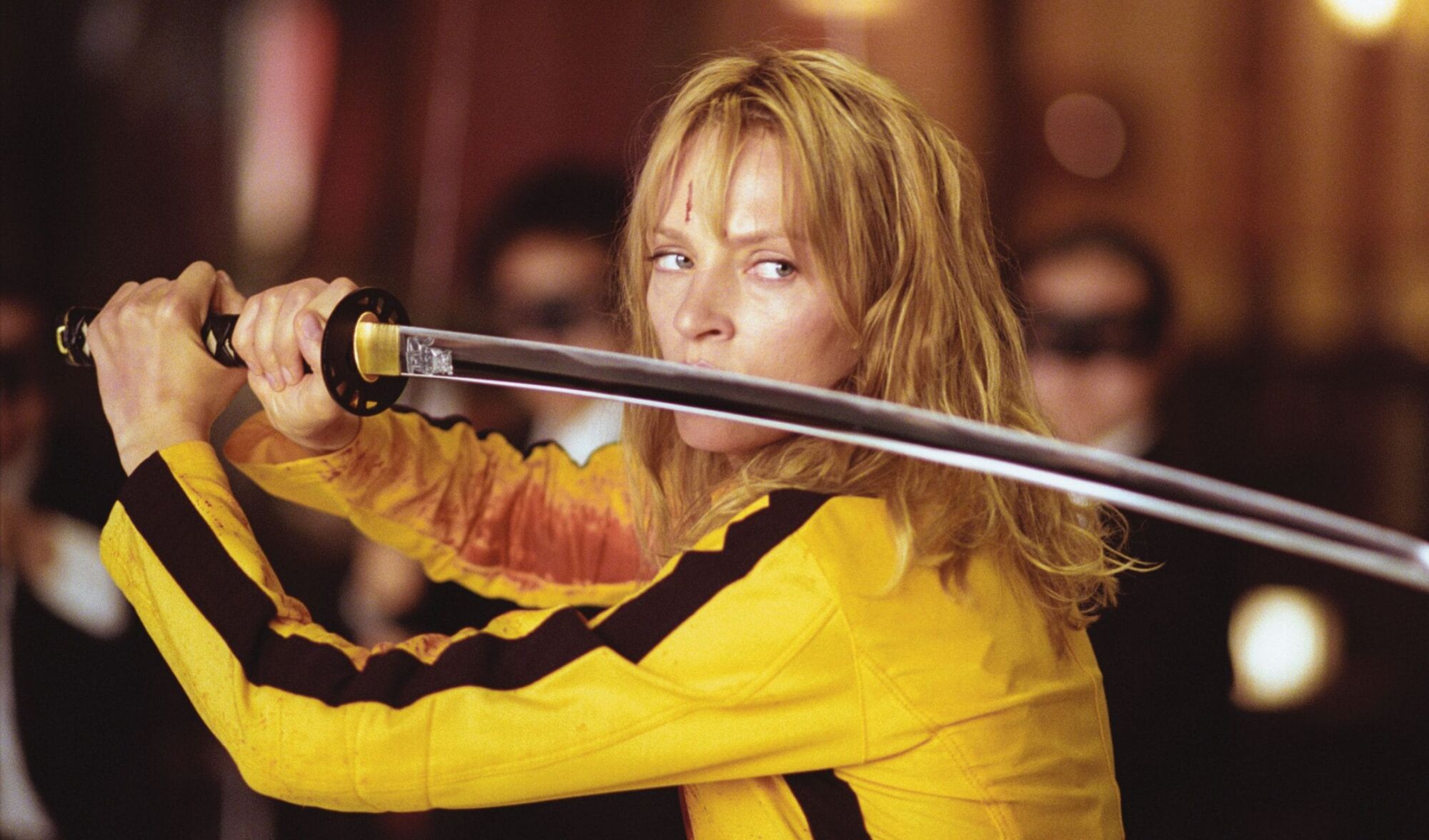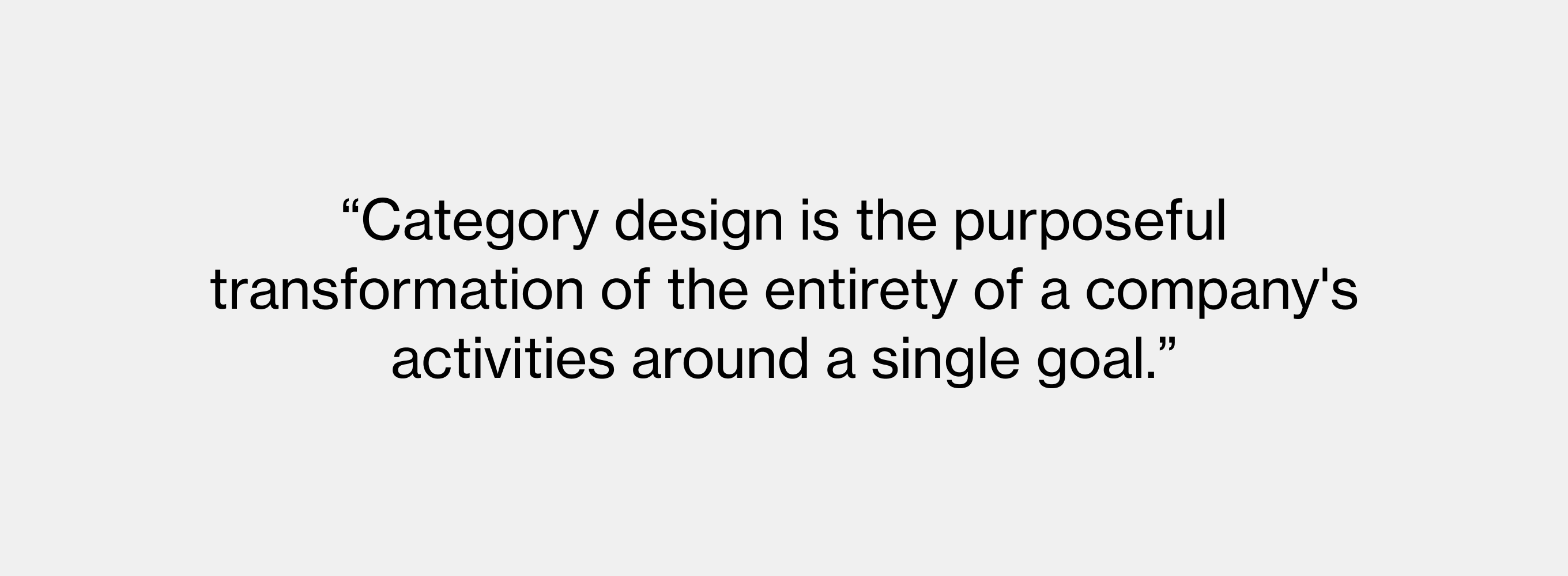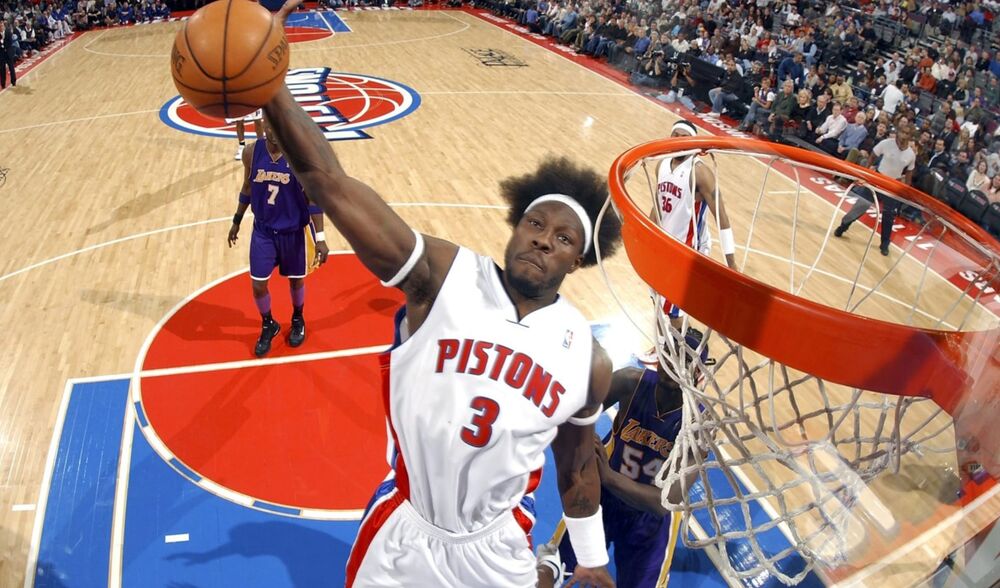A No-BS Approach to Category Design
My conversation with Anna Furminov from Modern Startup Marketing.


So much of what passes for “marketing strategy” is BS. It usually answers the question, “How are we going to convince someone we’re smart?” or “How are we going to put lipstick on this particular pig?” Of course, category design is not immune to being used this way, but when it’s done the right way it is the exact opposite of hype. It's defining a clear, whole-company direction—and then doing everything you can to deliver on it. Hype might follow, but real change must lead.
I recently sat down for a conversation with Anna Furmanov on her Modern Startup Marketing Podcast. We covered some really important ground, so I’m bringing it to you. We start by talking about what exactly is category design and talk about three key aspects of category design that make it uniquely suited to helping startups. We tackle the question of whether category creation is too hard to do or too expensive of an endeavor for most startups. (It’s not). And lastly we talk about how to make sure your category strategy never sets off anyone’s BS meter.
I hope you enjoy this conversation as much as I did.
Josh, I am fascinated. I can't lie. I'm fascinated by category design category creation. I've had folks on the show already, some of the more popular and more powerful episode. I know I'm not the only one that's fascinated by this. Christopher Lochheed was on the show, Andy Raskin, who talks more about strategic narrative, he was on the show. Now I'm talking to you and I love this because we're bringing you in to talk about your experience as you're helping different brands with category creation. So let's just start simple. What is category creation? What does it mean to you? Let's start there.
So we use the term category design, and category design is the purposeful transformation of the entirety of a company's activities around a single goal. And that goal is to define and lead a new market category. And there's a few words in there that are sort of important. So the purposeful transformation ... You could back your way into something like this. You could do it by mistake. You could just use intuition the whole way. That's not really category design. Category design says, "No, we're going to sit down and we're going to purposely try to create a new market category, and we're going to take our time and do it thoughtfully."

There's a couple other things that are important. It's the entirety of a company's activities. So category design is a whole company strategy. You work with the CEO and all of the executives that run product and sales and marketing. It's not just a marketing thing. And that's one of the great powers of category design is that it's a whole company strategy. And then the third thing is you're trying to define and lead a new market category. And in order to do that, you have to do something that is categorically different, and you have to get a large audience of people to believe that that category is something that's really valuable. So that's how I define it.
Well, I love it, because you broke it into three very important pieces. So thanks for sharing that. So let's talk about how you've helped different brands. You've helped Robinhood, Newsela, Uber . There's more out there that have created categories or there are more companies out there. You've helped these specific ones with category design. Where do you start? Can you tell me about your methodology? Where do you start? What does that process look like? Let's walk through maybe an example.
Yeah. So we've done this for over 50 companies now, and it's absolutely fascinating work, in part because every client comes to us with a different context. And the thing that is in common is that they're trying to disrupt the old way of doing things. But for our client Robinhood, they had already successfully created the category of no-fee investing. And so when we met them, they needed help with category growth. So we created a national TV campaign for them.
Another client, Clari, was in an emerging category, and this is something that a lot of startups do is they were in an emerging category of revenue operations and there was a few others. And the category hadn't really tipped in the mind of the customer yet, but people were category curious, in the world of the customer. And so what Clari needed help with was framing the category narrative so that all roads lead to Clari as the leader and away from their competitors.
And then another example, another client is Bizzabo, and they needed help earlier in category creation. So a lot of our clients, they had a vision for a new category. And in their case, it was one that would take the place of the category that they were already in, which was event management software. And so we help them define and launch the event experience category. So it all depends really on where the company is, but the thing that they all have in common is that category thinking is fundamental to their success.
So they're bought in, right? It's not like you have to change their mind or explain why it's important. They're already coming to you like, "We get it. We just need help to do this." Right.
Yeah. It's interesting because when I launched Gold Front, we launched as a creative studio, which is an interesting category. When we started, there weren't a lot of creative studios out there. And now nine years later, it's something you hear a lot, of agencies that are set up as a creative studio. And what happened along the way was we were talking to our clients who were mostly startups or innovation-led companies, and they were all already talking about category. And we had started doing a little bit of category strategy and we found that this was just on their minds, probably much more than what's our brand strategy going to be. And so that's when we ... Somewhere along the way, we made the switch to being a category design studio.
That makes sense. So first you're a creative studio and then changed into category design studio. So tell me, you mentioned Robinhood, they came to you, Clari, came to you, Bizzabo came to you. Where do you begin when they come to you and say, "We need your help with category design." How does it begin?
First thing is, we're just going to have a conversation with them. We're going to ask them about their business. Where are they trying to get to? What obstacles? That all happens during the sales process. We don't really pitch clients. We just sit and talk with them and try to especially talk with the CEO and the other executives about, "Where are you trying to get to? And what's in your way." And usually something forms from there. And then if we end up doing a project for them, we go into a period at the beginning where we just immerse ourselves in their business. So we're doing a bunch of desktop research. We're also doing stakeholder interviews with all the executives. So we'll usually do at least 8 to 10 stakeholder interviews. We may do stakeholder interviews with customers as well. And everybody is in a different place.
Some companies, some startups know they have some huge world-changing technology, but they're not sure how to make that meaningful for customers. Some feel like they're already in a category and how could we be category creators? We're sort of doing something similar to everybody else. So everybody has a different context, but the key during that time when we're really immersing ourselves in the category and doing stakeholder interviews, is we're looking for what problem do you uniquely solve? And we're going to write down as many of those ideas as we can. And whatever problem they uniquely solve, that is the seed of creating a new category. And usually for the clients who don't have some massive world-changing technology, they are just thinking a little too small about that differentiation. They're thinking, "The meaning of this differentiation in our product is it makes things easier. The customer can do things faster. They can do it cheaper." And that's just too small of a way to think about differentiation, if you want to be a category creator. And so what we help them do is take that seed of something that's different and really expand on that and turn that into something that is categorically different.
Now, maybe that sounds like, "Oh, is that just BS? Oh, do we just tell a story of something that's not very different and we amp it up?" No, because we're trying to figure out what big story we could tell and then we're also going, "Well, how might that affect the product roadmap?" So it's a really interesting dialogue between what story could we tell and then how could we actually have the real proof in what we do with the product roadmap in the future? And I think that is really how you get to category creation.
So that's fascinating. All of this is fascinating. Let me just ask then, so you made it clear how it starts. Can you tie that into a concrete example? Maybe if we talk about the different options that Clari had or Bizzabo had, or Robinhood had, or Uber had. Different options, and then you landed on the one. How do you land on that one? How does the decision making work out and then the next steps from there?
Yeah. So there are some details I can't get into because of confidentiality, but I can tell you that for somebody like Bizzabo, they were in the event-management software category, but they already had ideas about how this is not good enough. We really want to do something big with our product that's bigger than what this category is right now. They wanted to do something that was more experiential and more truly hybrid and a number of things. So they already had that idea. One of the first things we do after we do our stakeholder interviews and we do a couple workshops around category POV is we go into writing category concepts. And we have this mural board where the strategy team works together. And we come up with what's the possible concept for this category.
And in each of those concepts, we have three key story points. We have what big shift has taken place in the world that has thrown the world out of order. So we call that the shift. We have what is the big gap that's opened up for our clients' customers. What's a really big problem that our clients customers have, and what's the category idea that solves that gap? And so in this almost war-room area that we have in Miro, we've got strategists coming up with ideas and we're pitching each other, "Okay. The shift is this. It's the experience economy." There's all kinds of big shifts that are happening in technology and in culture and in business, then that's opened up a gap for our clients' customers. And that gap is not just they can't do this small thing. There's something really big that's a problem, sort of a latent problem or a latent need that maybe they're not even totally conscious of.
And then off of those two story points, what's the category idea that solves that big gap? And so in that moment, we realize that there's a number of different ways that our clients could go with something. And sometimes there's more options with certain clients than others. Other times we'll have clients where it's like, "No, it's pretty clear it's this one thing." But yeah, during that concepting phase is when we're looking at the possibilities, then we're presenting those concepts to CEO and the rest of the executive team, getting approval on one of them. Then we're going ahead and writing the strategic narrative.
And is there usually buy-in right away? Do you have to persuade? Or how does that psychology work?
Yeah, it's interesting because when we're doing workshops with clients, sometimes it can feel like you're in the dark a little bit. We're out wilderness. We're just trying to figure out what this thing is. And it's all sort of unknown. And usually when we come to present our first version of the strategic narrative, our clients are like, "Wow, how did you figure this out and really get us in such a short amount of time?"
Before that, in between those two moments, there's these category concepts. And there's a lot of debate and back and forth about those concepts. Sometimes our clients just know their business much better than we do. They lead us. They say, "No, this is what it needs to be. It's got to be over here. We know our customer." Sometimes because we're an outsider, we know better than them. Usually it's some kind of dialogue between the two, but it's interesting because especially the most important person that we work with is the CEO. And that collaboration is so key, because if the CEO doesn't truly believe the idea and the narrative in their bones, then it's not going to work. So we give a lot of attention to working with the CEO and making sure that we're really on the same page with that person.
So I heard you say strategic narrative, which is what Andy Raskin uses. And then category design is what you say you help companies with. Right? What's the relationship with that? Is category design how you then take the strategic narrative and make it flow throughout your entire company, so that then your product roadmap is aligned with it? How do you think about that?
So I think the guys that played bigger in Christopher Lochheed, they use the term category POV. And I think Andy Raskin uses strategic narrative. It's the same thing. A strategic narrative is just a little bit broader of a term because you could have a strategic narrative that isn't about a new category. When that strategic narrative is about the birth of a new category, it's a category POV. We use them somewhat interchangeably. I like the term strategic narrative, because it's essential that you have a really good story in there. So I like the word narrative being in there.
What would you say are the pitfalls that you've run into, or maybe the watch out? Let's say the folks listening in, some of them are founders. Some of the people are founders of startups. Maybe they're excited. They're planning to create and own a category. I've had a client that definitely wanted to go that route. It's just a matter of the right timing, when their product is ready. So what are the biggest pitfalls that you've found and what's your advice there?
So, first thing is every founder, every executive team, every CEO of a startup or innovation-led company needs to have a great, reliable story that's at the center of everything that they do. And many companies have, "Hey, we need to do ... This sales moment is really important. We got a prospect we need the CEO to speak to because the CEO's the only person who really tells the story the right way." Well, that's a sign that you've got a problem with your story. You need a story that anybody in the company could tell and it's really reliable. And so a great strategic narrative or category POV is what will help you get there. And so I think that our clients sometimes don't quite get how important that reliable story that every single person in the company, or at least all the executives and the sales people could tell, how valuable that is.
And then the second thing I would say is the reason why we don't do brand strategy anymore is because for our clients, they tend to not think of it as a whole-company strategy. I love doing category strategy, because the product team, the sales team, HR marketing, the CEO, they all tend to have the idea that, "Hey, this is a North Star for everything that we're going to do. This is going to not just affect what we say in the world, but it's going to affect our product roadmap." That's the kind of strategy that I want to write. I want to write the strategy that's going to be the North Star for the entire company. And I want them all working in alignment, working really well together. And one pitfall that we find once in a while is that sometimes companies hire us thinking, "Okay, this is more a marketing thing. It's more about what we say in the world." And it's just not as successful when you don't have the entire company all working towards the same goal.
And I think that ties into no matter what you want to call it, strategic narrative, or category point of view, or category design, or creation, or marketing, just simple. I think that ... Or brand strategy, if you're thinking that just belongs in the marketing department and everybody else is just going about their business, especially if you're at a high-growth startup and you're innovative, that's a losing strategy. So I don't think that the wording doesn't matter. I think we all agree that you need to have this flow throughout. It's almost like saying, "Well, sales can do their thing and not really talk to the customer success team." Or, "Product can do their thing and not really talk to marketing," or ... You're siloing the teams and then you're not actually creating the ... You're leaving money on the table or throwing money out the window.
Absolutely. And it's just a much more fun and happier way to work too, when everybody's working towards the same goal.
That's right. So critical question. I was just thinking about this because I just saw a clip on LinkedIn. I get some of my information on LinkedIn. I'm active on there. Where Drift CEO is talking ... Because Drift created categories. I think a few of them, they're pretty good at that. And he's saying that timing was super important, like, "We got lucky with the timing." And it's really hard and it's really expensive to create categories. And I'm just curious, how do you think timing plays into successful category creation? Because this is much bigger than just building your or talking about your product's features. What needs to click out there in the world for this category design to actually work?
Yeah. There's certainly a part of this that is more like alchemy and art than science. And I'm just thinking about when we start a category design project, we're spending the first few weeks really immersing ourselves in the category and the company and adjacent categories and potential customers. And so I think that's one of the really nice things about this process is it gives you a chance to really lay all the pieces out on the table and see what's emerging in business. And yeah, you need to find something that's totally new, so when people hear it, they go, "Yes, that's a categorical difference. That is a new species of product in the world," let's say. But it also needs to be close enough to what's going on today that it can't be so foreign that you're too early. And so there's a real art to looking at the business landscape and the cultural landscape and looking for the green shoots of a category somewhere and getting that timing right.
Do you think that it's still worthwhile? Do all of the clients that you work with, successfully they're able to create categories? It just seems like a hard thing to do, to help people, to educate people on this new category and why it's so important. There's a lot of money that goes into that. Right? Is it worthwhile?
Yes, absolutely. So we get this question all the time. Some people are like, "Well, can everybody be a category creator?" And I think of it as we're just keeping people honest, because especially when you start a startup, you're not going to your investors saying, "Hey, we think we have something incrementally different. We have something that's going to make an existing category a little bit better." They're going to their investors saying, "We're going to disrupt this industry. And that's why there's a ton of upside. And that's why you should give us 3 million or 16 million or 100 million or whatever." So that's what they're going to their investors with. And for those kinds of companies, category design holds their feet to the fire and says, "Hey, you had this idea. You're promising it to your investors. Now, do you really want to make it happen?

That makes sense. Thanks for being clear on that. And we're just keeping people honest. You're right. You don't go to your investor and say, "Well, we're just building something a little bit better than that other guy over there." Usually the message is, "We're disruptive. We're ..." For startups, right?
Right. 100% of our clients think of themselves as transforming an industry or transforming a field. And if you are transforming an industry or a field, you are a category creator.
That's right. That's powerful stuff. In the time that we have left, Josh, I'd love to ask you what are some goals for you this year, personal, professional, anywhere in between? What are you looking forward to?
You sent some of the questions ahead of time, so I had a little time to think about this, which was really nice. And so in my personal life, I want to work less. I want to go on a road trip with my daughters, Rae and Eve. I want to go to the beach and make s'mores and just not worry about anything else. And on the work side, I want to build a company that treats employees well and challenges them to do something maybe more than they even thought that they were capable of. And I also want to help founders chase their dreams and hopefully be a difference maker in their journey. And then on a broader level, I'd like to help those same founders launch categories that are more human categories that make the world healthier and not more sick.
Next.
